|
|
 |
|
Calanoida ( Order ) |
|
|
|
Diaptomoidea ( Superfamily ) |
|
|
|
Acartiidae ( Family ) |
|
|
|
Acartia ( Genus ) |
|
|
|
Acartiura ( Sub-Genus ) |
|
|
| |
Acartia (Acartiura) margalefi Alcaraz, 1976 (F,M) | |
| | | | | | | Syn.: | ? Acartia lefevrae Bradford,1976 (p.168, figs.F); ? Holmes, 2001 (p.35);
? Acartia clausi: Comaschi Scaramuzza, 1978 (part., p.16: Rem.) | | | | Ref.: | | | Alcaraz, 1976 (p.61, figs.F,M); 1983 (p.891); Coen & Mazzocchi, 1985 (p.789, figs.F,M); Ryan & al., 1986 (p.739); Zagami & Guglielmo, 1988-89 (p.61, figs.F,M); Cervelli & al., 1995 (p.117, Rem.: biol. mol.); Belmonte & Mazzocchi, 1997 (p.252, figs.F,M); Belmonte & Cavallo, 1997 (p.377); Belmonte, 1998 a (p.38, fig., Rem.: eggs); Bradford-Grieve, 1999 (n°181, p.4, figs.F,M); Castro-Longoria, 2001 (p.225, fig.1); Avancini & al., 2006 (p.111, Pl. 79, figs.F,M, Rem.); Vives & Shmeleva, 2007 (p.424, figs.F,M, Rem.); Gubanova & al., 2013 (in press, Rem: p.2, Table 1, 4, fig.2). | 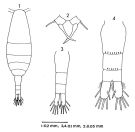 issued from : M. Alcaraz in Inv. Pesq. 40 (1). [Fig.3, p.63]. Female (from Ria de Vigo, NW Spain): 1, habitus (dorsal view); 2, P5; 3, urosome (dorsal view). 4, urosome (dorsal view from Acartia clausi. Specimens located in the Ria of Vigo (NW Spain). Rem: P5 = fifth leg
|
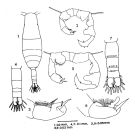 issued from : M. Alcaraz in Inv. Pesq. 40 (1). [Fig.2, p.62]. Male: 1, habitus (dorsal view); 2, P5; 3, left terminal segment of P5; 4, urosome (dorsal view) Acartia clausi Male: 5, P5; 6, left terminal segment of P5; 7, urosome (dorsal view). Specimens located in the Ria of Vigo (NW Spain). Rem: P5 = fifth leg
|
 issued from : M. Alcaraz in Inv. Pesq. 40 (1). [Table 1, p.71]. Comparison between Acartia margalefi and Acartia clausi. Specimens located in the Ria of Vigo (NW Spain).
|
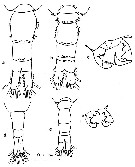 issued from : G. Zagami & L. Guglielmo in Mem. Biol Mar. Oceanogr.,1988-89, 17. [p.62, Fig.1]. Comparison between and Acartia margalefi from Sicilia (Italia).
Acartia clausi: a, urosome female (dorsal view); b, urosome male (dorsal view); c, P5 male.
Acartia margalefi: d, urosome female (dorsal view); ; e, urosome male (dorsal view); f, P5 male.
|
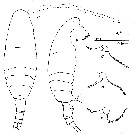 issued from : J.M. Bradford in N. Z. Jl Mar. Freshw. Res., 1976, 10 (1). [p.168, Fig.5]. As . With doubt.
Female (from W France: Brest Harbour; Italy: Genoa Harbour): a-b, habitus (dorsal and lateral, respectively); c-e, P5.
|
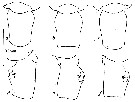 issued from : J.M. Bradford in N. Z. Jl Mar. Freshw. Res., 1976, 10 (1). [p.169, Fig.6]. As . With doubt.
Female: genital segment. a-c, dorsal view; d-f, lateral view.
|
 issued from : J.M. Bradford in N. Z. Jl Mar. Freshw. Res., 1976, 10 (1). [p.170, Fig.7]. As . With doubt.
Male (from W France: Brest Harbour; Italy: Genoa Harbour): a-b, habitus (dorsal and lateral, respectively); c, P5 (posterior surface).
|
 issued from : E.V. Pavlova & A.A. Shmeleva in Vestnik zoologii, 2010, 44 (2). [p. e-5, Table 2]. Female: Dimensions and morphological characteristics. Nota ** : cites from Table 1 the dimensions for A. margalefi (Sevastopol) adopted from Belmonte & Mazzocchi, 1997.
|
 Issued from : M.G. Mazzocchi in Guida al Riconoscimento del plancton dei Mari Italiani, Vol. II, 2006. [p.87, Tav. 79]. After A. Comaschi. Female: a-b, habitus (dorsal and lateral, respectively); c, urosome (dorsal); e, P5. male: f, habitus (dorso-lateral); g, urosome (dorsal); h, P5 (posterior view); ; i, exopodal segment 2+3 of left P5.
| | | | | Compl. Ref.: | | | Comaschi Scaramuzza, 1987 (tab.1); Ceccherelli & al., 1987 (p.571 fig.5); Belmonte & al., 1989 (p.519); Jouffre & al., 1991 (p.489, lagoon); Alcaraz & Saiz, 1991 (p.137, fig.3, Table II, turbulence effects); Saiz & Alcaraz, 1992 (tab.1); Mauchline, 1998 (tab.8, 78, p.508: Rem.); Siokou-Frangou, 1999 (p.478); Belmonte & Potenza, 2001 (p.174); Comaschi & al., 2001 (p.523, pluriannual abundance); Bressan & Moro, 2002 (tab.2); Zagorodnyaya & al., 2003 (p.52); Vaglio al., 2005 (p.163); Smeleva & Selifonova, 2005 (p.57); Camatti & al., 2006 (p.46, fig.5); Valdés & al., 2007 (p.104: tab.1); Sei & Ferrari, 2006 a (p.1, Rem.); Rossi, 2008 (p.90: Tableau XII); Aravena & al., 2009 (p.621, seasonal & spatial distribution vs. environmental factors); Mazzocchi & Di Capua, 2010 (p.423); Mazzocchi & al., 2011 (p.1163, fig.6, long-term time-series 1984-2006); Vidjak & al., 2012 (p.243, Rem.: p.253); Mazzocchi & al., 2012 (p.135, annual abundance 1984-2006); Belmonte & al., 2013 (p.222, Table 2, abundance vs stations); Lidvanov & al., 2013 (p.290, Table 2, % composition) ; Pansera & al., 2014 (p.221, Table 2, abundance); Zaafa & al., 2014 (p.67, Table I, occurrence): Uriarte & al., 2016 (p.718, fig.5: abundance vs years 1998-2011); El Arraj & al., 2017 (p.272, table 2, spatial distribution); Belmonte, 2018 (p.273, Table I: Italian zones); Camatti & al., 2019 (p.1, fig. 3, 5, 6, 7, 8, 9, 10, Table 1, 4, 5, Rem.) | | | | NZ: | 3 | | |
|
Distribution map of Acartia (Acartiura) margalefi by geographical zones
|
| | | | | | | | |  Issued from : M.G. Mazzocchi, L. Dubroca, C. Garcia-Comas, I. Di Capua & M. Ribera d'Alcalà in Progr. Oceanogr., 2012, 97-100. [p.143, Fig.10]. Issued from : M.G. Mazzocchi, L. Dubroca, C. Garcia-Comas, I. Di Capua & M. Ribera d'Alcalà in Progr. Oceanogr., 2012, 97-100. [p.143, Fig.10].
Long-term variability of the abundance (Ind. m3) of rare copepod species that disappeared in the second period of the time-series at Station MC (Gulf of Naples), by vertical tows in the upper 50 m.
Mazzocchi & al. (2012, p.148) point to this species is typically found in harbors and other semi-enclosed systems such as coastal ponds. It was a dominant copepod in the Venice Lagoon until the late 1980s when in the 1990s it was replaced by Acartia tonsa introduced in the mediterranean in the early 1980s. During the same period, A. margalefi has also almost disappeared from the Po River Delta and has drastically reduced its confinement to littoral lakes along the Tyrrhenian coasts. |
 issued from : M. Alcaraz in Inv. Pesq. 40 (1). [p.64, Fig.4]. issued from : M. Alcaraz in Inv. Pesq. 40 (1). [p.64, Fig.4].
Comparison between Acartia margalefi and Acartia clausi.
Specimens located in the Ria of Vigo (NW Spain): Variation of the metasome length along the years. Continuous line: females; dotted line: males. |
| | | | Loc: | | | Norway (Svartatjönn), North Sea, W Ireland (Killary Harbour), ? River of Morlaix, Southampton, ? Brest Harbour, Arcachon, Bilbao estuary, Ria de Arosa, Ria de Vigo, Morocco-Mauritania, W Tangier, Medit. (Barcelona & Masnou harbours, Bages-Sigean lagoons, Thau lagoon, Toulon Harbour, Genoa harbour, G. of Naples, Sicilia, Messina Strait, Lake Faro, Taranto, S Adriatic Sea, Venise, Po delta, Island of Pag, G. de Saronikos, Aegean Sea, Black Sea).
Type locality: Ria de Vigo (NW Spain) | | | | N: | 35 | | | | Lg.: | | | (185) F: ± 0,792; M: ± 0,778; (251) F: 0,864-0,8; M: 0,821-0,774 [Norvège]; F: 0,85-0,764; M: 0,839-0,702 [Sebastopol]; {F: 0,764-0,85; M: 0,702-0,839} | | | | Rem.: | Sometimes confounded with Acartia clausi in brackish waters, but of much smaller dimensions, as A. teclae.
This species is dedicated to Ramon Margalef, Professor of Ecology at the University of Barcelona.
My students at the Laboratoire Arago (Laboratory Arago in Banyuls sur Mer that he knew well) studied his works as models of creativity. Fertile spirit, boiling with ideas, playing with physico-ecological concepts, one could characterise him as the "Dali" of Oceanography, other great Catalan personality. Under a serious and severe cover, he had a great sense of humour, defining a copepod as: "a fifth leg attached to something". (see: Hommage to Ramon Margalef in Oecologia aquatica, 10, Publ. Universitat de Barcelona, 1992).
Vives & Shmeleva (2007, p.425) do not admit the synonymy with Acartia lefevrae, contrary to Bradford-Grieve (1999, p.4). Some localisations are debatable in brackish waters (estuaries and harbour installations).
For Sei & Ferrari (2006 a, p.1, 2) the new occurrence of A. tonsa in the Lisa lagoon (S. Adriatc Sea) may have caused the disappearance of the A. margalefi. Like in the Venice's Lagoon after Camatti & al. (2006, p.51-52).
See remaks in Acartia californiensis. | | | Last update : 25/10/2022 | |
|
|
 Any use of this site for a publication will be mentioned with the following reference : Any use of this site for a publication will be mentioned with the following reference :
Razouls C., Desreumaux N., Kouwenberg J. and de Bovée F., 2005-2025. - Biodiversity of Marine Planktonic Copepods (morphology, geographical distribution and biological data). Sorbonne University, CNRS. Available at http://copepodes.obs-banyuls.fr/en [Accessed November 30, 2025] © copyright 2005-2025 Sorbonne University, CNRS
|
|
 |
 |













